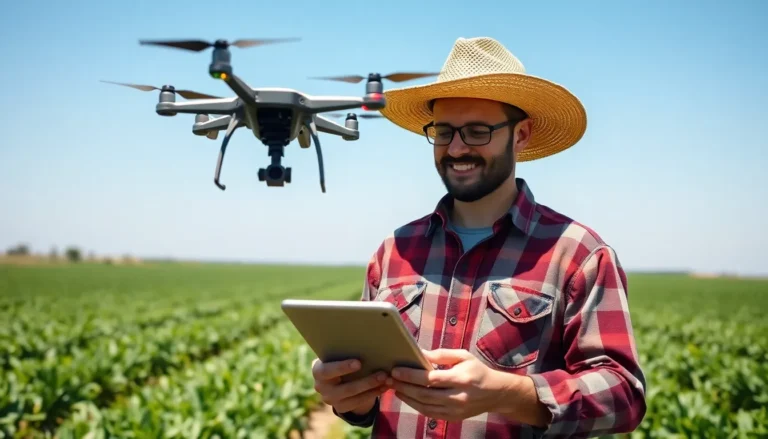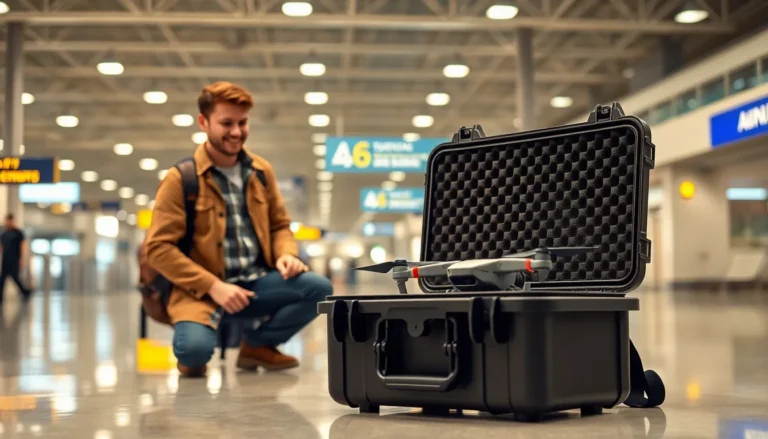Drones have become the buzzing stars of the skies, but what happens when they start hovering over U.S. military bases? It’s not just a scene from a sci-fi movie; it’s a reality that raises eyebrows and questions. Picture this: tiny flying robots zipping around top-secret installations, capturing everything from training exercises to lunch breaks. It sounds like a plot twist, but it’s happening right now.
Table of Contents
ToggleOverview of Drones Flying Over US Military Bases
In recent years, drones have significantly increased their presence over U.S. military bases. These unmanned aerial vehicles capture a variety of activities, which raises privacy and security concerns. Often, drones monitor training exercises and other critical operations. Various entities operate these drones, including commercial companies, hobbyists, and potential adversaries.
Multiple reports indicate that the unauthorized use of drones over military installations is on the rise. They fly at altitudes that can easily bypass radar detection systems. Such abilities give them the capacity to gather crucial intelligence, making military operations vulnerable. Officials express alarm over the potential for drones to infringe upon military protocols.
Moreover, regulatory measures struggle to keep pace with drone technology advancements. The Federal Aviation Administration (FAA) emphasizes the importance of maintaining safe airspace around sensitive facilities. Local and federal authorities coordinate efforts to establish no-fly zones, aiming to mitigate risks associated with drone surveillance.
Drones raised alarm during training events, capturing footage intended for internal use only. Privacy experts highlight that unauthorized surveillance can lead to exposing tactics and strategies. Military officials recognize the need for comprehensive policies to address drone operations in these areas.
The combination of technological capabilities and public accessibility makes drones a substantial challenge. They pose significant threats to operations valued by national security. As the dialogue around drone usage evolves, understanding the implications for military readiness and safety remains critical.
The Role of Drones in Modern Warfare
Drones play a significant role in contemporary military operations. Their usage has transformed combat dynamics and intelligence gathering.
Advantages of Military Drones
Military drones provide numerous benefits. They enhance situational awareness through real-time surveillance, which allows for informed decision-making during missions. Cost-effectiveness is another advantage; drones reduce the need for manned aircraft, decreasing operational costs. Precision strikes lead to minimized collateral damage, improving mission outcomes. Drones also operate in high-risk environments where human presence poses substantial threat. Operators can control these unmanned systems from secure locations, reducing personnel risk during critical missions.
Risks and Challenges
Despite their advantages, military drones present risks and challenges. Unauthorized drone surveillance can compromise operational security, risking exposure of sensitive tactics. Regulatory gaps in drone management mean that oversight often lags behind technological advancements. Increased dependency on drones may create vulnerabilities, as adversaries adapt and develop counter-drone strategies. You may also find privacy concerns arise, leading to tension between military operations and civil liberties. Adapting policies to manage these challenges remains imperative for maintaining operational integrity.
Incidents of Drones Flying Over US Military Bases
Drones have increasingly become a concern above U.S. military bases, with several notable incidents raising alarms about security and operational integrity. Unauthorized drone flights have occurred over various bases, exposing vulnerabilities and prompting serious discussions about privacy rights and military protocols.
Notable Events and Their Implications
Several high-profile incidents underscore the risks posed by drones near military installations. In 2020, a drone flew over a base in Virginia, capturing sensitive training exercises. This unauthorized surveillance led to increased scrutiny of security measures. The presence of drones during live-fire exercises poses risks to personnel and operational secrecy. Documented instances reveal adversaries using drone technology to gather intelligence, prompting military forces to anticipate evolving threats. Military readiness may be compromised if these unauthorized flights remain unaddressed.
Response from Military Authorities
Military authorities have implemented strategies to counter increasing drone activities. Enhanced radar systems are being developed to detect unauthorized drones effectively. Security protocols around bases are under review to address vulnerabilities. Collaboration with federal agencies, including the FAA, aims to create comprehensive no-fly zones. Drone detection and interdiction technologies are prioritized to safeguard sensitive operations. Engaging with local law enforcement is essential for monitoring drone activity in surrounding areas. These measures demonstrate commitment to maintaining national security and operational effectiveness.
Legal and Regulatory Framework
Drones operating near U.S. military bases prompt significant legal and regulatory considerations. The increasing incidence of unauthorized drone flights complicates safeguarding sensitive areas.
Current Regulations Governing Drone Use
Federal Aviation Administration regulations govern drone usage nationwide. Drone operators must adhere to designated airspace restrictions, especially around military facilities. Security measures include no-fly zones aimed at minimizing risks. Operators must register their drones and comply with altitude limitations. Enforcement efforts are crucial to preventing unauthorized surveillance and protecting operational security.
Proposed Changes and Future Directions
Regulatory bodies are exploring updates to existing drone policies. Proposed changes would enhance restrictions around military bases to better mitigate threats. Discussions include improved communication between civilian operators and military authorities. Emphasizing educational programs could inform the public about safe drone practices. As technology evolves, adaptive regulations must keep pace to ensure national security.
Public Perception and Concerns
Drones flying over U.S. military bases spark significant public discourse. The implications of these sightings raise valid concerns about safety and ethics.
Safety and Security Issues
Increased drone activity near military installations poses notable security challenges. Unauthorized drones may capture sensitive information, threatening operational integrity. Risks arise not only from surveillance but also from potential collisions with manned aircraft. Authorities stress the importance of robust radar systems to detect rogue drones. Current regulations often lack enforceability, complicating efforts to maintain secure airspace. Comprehensive no-fly zones become essential in mitigating these threats. Protecting military operations from unauthorized surveillance ensures national security is upheld.
Ethical Considerations
Public concerns about privacy escalate as drones surveil military areas. Ethical implications surface when civilian operators fly drones near sensitive installations. Surveillance capabilities of drones blur the lines between national security and individual privacy rights. Transparency in drone operations promotes public trust and accountability. Discussions around drone use necessitate balanced perspectives on freedom and security. Crafting policies that address both safety and ethical issues promotes understanding between authorities and the community. Enhanced communication channels allow for clearer guidelines on acceptable drone usage around military bases.
The growing presence of drones over U.S. military bases presents significant challenges that demand urgent attention. As these unmanned aerial vehicles continue to encroach upon sensitive areas the risks to national security and operational integrity become increasingly pronounced.
Military authorities are actively enhancing security measures and developing regulations to combat unauthorized drone flights. However the balance between leveraging drone technology for operational efficiency and safeguarding privacy rights remains delicate.
Ongoing dialogue among military officials regulatory bodies and the public is essential to create a framework that addresses both safety and ethical concerns. As drone technology evolves so too must the policies that govern its use to ensure the protection of critical military operations and maintain public trust.





